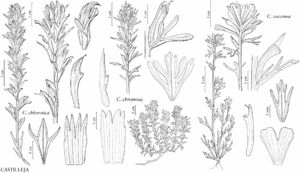Castilleja chromosa
Bull. Torrey Bot. Club 26: 245. 1899. (as Castilleia)
Herbs, sometimes subshrubs, perennial, 1.5–3.5(–4.5) dm; from a woody caudex; with a taproot. Stems several to many, ascending to erect, often grayish, unbranched, rarely branched, sometimes with short, leafy axillary branches, hairs spreading-erect, long, stiff, eglandular, sometimes also with shorter, stipitate-glandular ones. Leaves gray-green, linear, lanceolate, or oblanceolate, sometimes broadly lanceolate, (1.5–)2.5–6(–7) cm, not fleshy, margins plane, involute, (0–)3–5(–7)-lobed, sometimes with secondary lobes, apex acuminate to obtuse; lobes spreading, linear, apex acuminate. Inflorescences 2.5–15 (much longer in fruit) × 1.5–5.5 cm; bracts proximally greenish to dull purplish, distally bright red to scarlet or orange-red, rarely yellowish to dull orange or pink, narrowly to broadly linear or lanceolate, narrowly ovate, or oblong-lanceolate, (0–)3–7-lobed, rarely with secondary lobes; lobes spreading, linear to oblong, sometimes oblanceolate, often expanded near tip, long, proximal lobes arising below mid length, apex rounded or obtuse to sometimes acute. Calyces colored as bracts, sometimes with broad yellow band below colored lobe apices, (17–)20–27 mm; abaxial clefts 4–10 mm, adaxial 6–12 mm, abaxial ca. 30% of calyx length, adaxial ca. 40% of calyx length, deeper than laterals, lateral 1–4 mm, ca. 15% of calyx length; lobes oblong or ovate to narrowly triangular or lanceolate, apex obtuse to rounded. Corollas straight or ± curved, 18–35(–40) mm; tube 8–15 mm; beak short- or long-exserted, adaxially green to yellow-green, (9–)10–18 mm; abaxial lip deep green, reduced, thickened, included to exserted, 2–3 mm, ca. 20% as long as beak; teeth incurved, deep green, 0.5–1 mm. 2n = 24, 48.
Phenology: Flowering (Feb–)Mar–Aug(–Nov).
Habitat: Dry sagebrush slopes and flats, pinyon-juniper stands, blackbrush, open yellow pine forests.
Elevation: 500–3200 m.
Distribution
Ariz., Calif., Colo., Idaho, Nev., N.Mex., Oreg., Utah, Wyo.
Discussion
Castilleja chromosa is sometimes confused with 3b. C. angustifolia var. dubia (see discussion there). Castilleja chromosa retains its distinctive morphology across its wide range and is a characteristic species of much of the southwestern United States. Where it overlaps with C. angustifolia, the two are distinguished by inflorescence color and width and by the lengths of the calyx, corolla, and corolla beak. In the broad region of their sympatry, there is little evidence of intergradation, except in a few sites in Elko County, Nevada, and in southern Wyoming. Throughout southern Idaho and northeastern Nevada the range of the two overlap with little or no intergradation. At high elevations in Montrose County, Colorado, C. chromosa has narrower leaves and a longer and silkier pubescence, especially in the inflorescence. Apparent hybrids between C. chromosa and C. flava var. rustica are known from Custer County, Idaho, and hybrids with C. linariifolia are known from Montrose County, Colorado.
Selected References
None.
